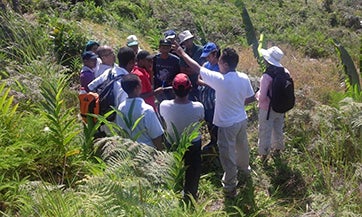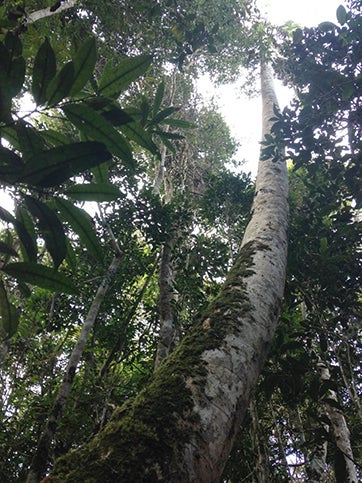 July 12, 2016 As Madagascar prepares to move into implementation of REDD+ through its watershed-based ER-Program, over the humid forests of the East coast, the technical work begins. The National REDD+ Coordination Office of Madagascar (BNCR) has started of intensive field work on forest inventories. This work will create a detailed map of the current forest type in this ecoregion and provide information on biomass for the creation of the Reference Emission Level (REL). The objective of the inventory work is to gather information on the carbon stocks of the different forest types, but also to conduct an exhaustive analysis of the ecological state of the forests represented in this ecoregion, well known for its biodiversity and endemic species hotspots.
July 12, 2016 As Madagascar prepares to move into implementation of REDD+ through its watershed-based ER-Program, over the humid forests of the East coast, the technical work begins. The National REDD+ Coordination Office of Madagascar (BNCR) has started of intensive field work on forest inventories. This work will create a detailed map of the current forest type in this ecoregion and provide information on biomass for the creation of the Reference Emission Level (REL). The objective of the inventory work is to gather information on the carbon stocks of the different forest types, but also to conduct an exhaustive analysis of the ecological state of the forests represented in this ecoregion, well known for its biodiversity and endemic species hotspots.
A first methodological workshop, which took place at the end of April, brought together government and non-government experts to establish a precise definition of deforestation, degradation and carbon stock enhancement at national scale. Participants in the workshop also completed the important task of defining the forest inventory protocol in-line with REDD+ objectives (carbon and safeguards), in close collaboration with the National Forestry Resources Management Office. It has been thus jointly decided to focus the ongoing inventory on the forested areas with high potential for carbon stock enhancement, the so-called “secondary forest” that regenerates after traditional slash-and-burn agricultural practices. The decision to focus inventory work on secondary forests takes into account previous inventories conducted in 2013 within the intact and degraded humid forest within the program area, thus filling in the gaps to provide sufficient information to finalize the REL of deforestation and potentially for degradation (the integration of degradation is currently under discussion between BNCR and REDD+ stakeholders). Additionally, the methodologies for conducting a carbon inventory and for measuring environmental and social indicators will be conducted over many of the same plots, allowing integration of carbon, ecological, and social information on the forest.

Following the initial design workshop, BNCR hosted a second workshop from May 3-6, to train 80 technicians, half of whom are women, on the inventory methodology previously adopted and the equipment that will be used in the inventory (e.g., relascopes, vertex, GPS). The workshop also tested the new methodology within the different forest types that will be covered by the inventory. BNCR has designed the training to include participation by a range of institutions (e.g., NGOs, government institutions, development agencies), in order to ensure the representation and involvement of all stakeholders in this important step of the REDD+ process.
Given the global importance of Madagascar’s forests in terms of endemic biodiversity, the inventory is designed to include strong collaboration with local native experts of fauna and flora, in order to be as precise as possible in the description of these highly diverse forests. The inventory is also designed to integrate important information about the interaction between local populations and these ecosystems and to identify potential opportunities for local action to reduce deforestation and degradation and enhance carbon stocks. Nearly half of these local experts are women, offering the REDD+ process an additional opportunity for gender balance and additional perspectives and expertise feeding into inventory results.
BNCR has emphasized to all participants the importance of their role in the REDD+ process, considering the need for high quality data and local expertise, in order to provide credible information for emission reduction calculation but also environmental and social impacts and opportunities. BNCR has also highlighted that the inventories are not only a preliminary step of REDD+ implementation, but also a major aspect of the Monitoring, Reporting and Verification system for the ER-Program. The Ministry of the Environment, under which BNCR manages REDD+ activities, has emphasized the importance of this work. Madagascar’s Minister of Environment, Ecology and Forest, Bénédicte Johanita Ndahimananjara, participated in the final day of the workshop, and remarked, “With about 80 participants, this workshop…. tackles important issues, not only in terms of capacity building of our field agents, but also to develop sufficient high quality data to strongly establish emission reduction programs over Madagascar.”
